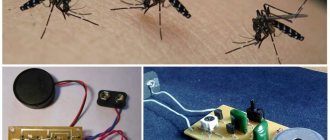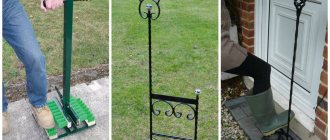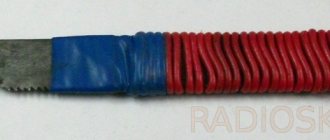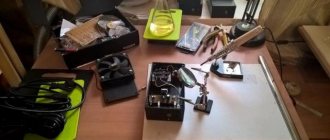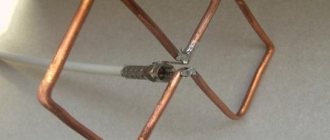An ultrasonic emitter is a generator of powerful ultrasonic waves. As we know, a person cannot hear ultrasonic frequency, but the body feels it. In other words, the ultrasonic frequency is perceived by the human ear, but a certain part of the brain responsible for hearing cannot decipher these sound waves. Those who are involved in building audio systems should know that high frequencies are very unpleasant for our hearing, but if we raise the frequency to an even higher level (ultrasonic range), the sound will disappear, but in fact it is there. The brain will try to decode the sound unsuccessfully, resulting in headache, nausea, vomiting, dizziness, etc.
Ultrasonic frequency has long been used in a variety of fields of science and technology. Using ultrasound, you can weld metal, do laundry, and much more. Ultrasound is actively used to repel rodents in agricultural machinery, since the body of many animals is adapted to communicate with their own kind in the ultrasonic range. There is also data about repelling insects using ultrasound generators; many companies produce such electronic repellents. We suggest you assemble such a device yourself, according to the diagram below:
Let's consider the design of a fairly simple high-power ultrasonic gun. The D4049 chip works as an ultrasonic frequency signal generator; it has 6 logic inverters.
The microcircuit can be replaced with a domestic analogue K561LN2. The 22k regulator is needed to adjust the frequency; it can be reduced to the audible range if the 100k resistor is replaced with 22k, and the 1.5nF capacitor is replaced with 2.2-3.3nF. Signals from the microcircuit are supplied to the output stage, which is built on only 4 medium-power bipolar transistors. The choice of transistors is not critical, the main thing is to select the complementary pairs that are as close as possible in terms of parameters.
Literally any HF heads with a power of 5 watts or more can be used as a radiator. From the domestic interior, you can use heads like 5GDV-6, 10GDV-4, 10GDV-6. Such HF heads can be found in acoustic systems manufactured in the USSR.
All that remains is to arrange everything into the body. To direct the ultrasonic signal, you need to use a metal reflector.
Necessary for a very wide range of devices - repellers of mice, mosquitoes, dogs. Or simply as an ultrasonic washing machine. Also, with this EPU you can carry out interesting experiments and experiments (comrades add: including with neighbors :)). Can be used to reduce the time of etching and washing of printed circuit boards, reduce the time of soaking laundry. The acceleration of chemical processes in a liquid irradiated with ultrasound occurs due to the phenomenon of cavitation - the appearance in the liquid of many pulsating bubbles filled with steam, gas or a mixture of them and the sonic capillary effect. Below is a diagram of an ultrasonic variable frequency generator, taken from the Radioconstructor magazine.
The circuit is based on two rectangular pulse generators and a bridge power amplifier. A tunable ultrasonic frequency meander pulse generator is made on logic elements DD1.3, DD1.4. Its operating frequency depends on the capacitance of capacitor C3 and the total resistance of resistors R6, R4. The greater the resistance of these resistors, the lower the frequency. A low-frequency generator with an operating frequency of about 1 Hz is made using elements DD1.1, DD1.2. Both generators are connected to each other through resistors R3, R4. Capacitor C2 is designed to ensure that the frequency of the high-frequency generator changes smoothly. If capacitor C2 is bypassed with switch SA1, then the frequency of the high-frequency generator will be constant. A bridge pulse power amplifier is made using the DD2 chip and field-effect transistors. The inverters of the microcircuit drive push-pull repeaters on field-effect transistors. When at pins 3, 6 DD2 log. Oh, then there will be a log at the outputs DD2.3, DD2.4. 1. Accordingly, at this moment in time transistors VT1, VT4 will be open, and VT2, VT4 will be closed. Using a square wave signal results in harmonic-rich acoustic emissions. Two high-frequency dynamic heads of type 2GD-36-2500 are used as ultrasound emitters. You can also use 6GD-13 (6GDV-4-8), EGD-31 (5GDV-1-8) and other similar ones. If possible, it is advisable to replace them with a powerful piezoceramic emitter or magnetostrictor, which you can try to make yourself by winding several dozen turns of stranded copper wire on a ferrite U-shaped core from the TV fuel assembly, and using a small steel plate as a membrane. The coil must be placed on a massive support. P-channel field-effect transistors can be replaced with IRF5305, IRF9Z34S, IRF5210; p-channel - IRF511, IRF541, IRF520, IRFZ44N, IRFZ48N. Transistors are installed on radiators. The microcircuits can be replaced with 564LA7, CD4011A, K561LE5, KR1561LE5, CD4001B. Choke L1 - any miniature inductance 220.... 1000 µH. Resistors R7, R8 are homemade wireframes. Variable resistor SP3-30, SP3-3-33-32 or with power switch SP2-33-20. Download the printed version in the archive.
Setup. The motor of the variable resistor R5 is set to the middle position, the contacts of the switch SA1 are closed, by selecting the capacitance of the capacitor C3 and the resistance of the resistor R6, the generator frequency is set to DD1.3, DD1.4 about 30 kHz. Next, contacts SA1 open and by selecting the resistances of resistors R2, R3 and R4, the ultrasonic frequency deviation should be set from 24 kHz to 35...45 kHz. It should not be made wider, since either the operation of the device will become audible to humans, or the switching losses of field-effect transistors will noticeably increase, and the efficiency of the sound emitters will decrease. Disruption of the generator on DD1.3, DD1.4 is not allowed, as this can lead to damage to the dynamic head coils. The power source must be designed for a current of at least 2 A. The supply voltage can be from 11 to 13 volts.
Today I assembled this circuit for an ultrasonic emitter - it doesn’t work very well, but! Having thought a little, I came to the conclusion that it was necessary to increase the capacity of C3 to 2200 pF, then naturally the error in the circuit was eliminated - in the DD2.2 element, pins 4 and 6 were mixed up. And lo and behold, it works. True, it is not possible to withstand this piercing sound for a long time, varying over a wide range, even for those who are in other rooms. My head doesn’t even begin to hurt, but it’s as if it’s being squeezed in a vice, a sickeningly disgusting state, I lasted about 30 seconds.
The current consumption can be calculated based on the resistance of the ultrasonic emitter used; I think everyone remembers Ohm’s law. For example, I have it at 16 Ohms, taking the efficiency of 100% of the final stage as the efficiency, which is almost the case, we get 750 mA at a supply voltage of 12 V. The voltage should not be changed, otherwise the power will drop, and what’s the point of reducing it? I power my ultrasonic emitter from a 12 V power bank. When the voltage drops, the frequency is more or less stable. The range of output frequencies varies widely with a variable resistor from the audible spectrum to the inaudible, it is only necessary to select the correct duty cycle of the pulses for the correct operation of the circuit. The device was assembled and tested by: GOVERNOR.
To generate ultrasound, special magnetostrictive type emitters are used. The main parameters of devices include resistance and conductivity. The permissible frequency value is also taken into account. The design of the devices may differ. It should also be noted that the models are actively used in echo sounders. To understand the emitters, it is important to consider their design.
Device with yar
Making a magnetostrictive emitter with your own hands is quite simple. First of all, a stand for the rod is prepared. Next, it is important to cut out the stand. You can use a metal disk for this. Experts say that the stand should be no more than 3.5 cm in diameter. The terminals for the device are selected for 20 V. A ring is fixed at the top of the model. If necessary, you can wrap electrical tape. The resistance indicator for emitters of this type is around 30 Ohms. They operate with a conductivity of at least 5 microns. In this case, no winding is required.
Double winding model
Double winding devices are produced in different diameters. The conductivity of the models is at around 4 microns. Most devices have high characteristic impedance. To make a magnetostrictive emitter with your own hands, only a steel stand is used. In this case, an insulator is not required. The ferrite rod can be installed on the pad. Experts recommend preparing an O-ring in advance. It should also be noted that to assemble the emitter you will need a field-type capacitor. The input resistance of the model should be no more than 20 Ohms. The windings are installed next to the rod.
DIY passive radiator
You can easily make a passive radiator with your own hands by removing the magnetic system and moving coil from the low-frequency speaker. It is better to use a bass driver with a diameter no smaller than the intended active driver. It would also be a good idea to make the diffuser a little heavier.
It is not necessary to dissect a normal speaker to make a passive speaker out of it with your own hands. It is better to use it for its intended purpose, and in addition to it, it is cheap to buy a passive radiator on AliExpress.
The passive radiators shown above are great for creating homemade portable speakers. They have a diameter of 2 inches and cost only 143 rubles per pair
.
I recommend buying from this store
.
An even more interesting option:
These passive radiators are less like conventional speakers, because... do not have a metal basket and have minimal thickness. They have a diameter of 3 inches (79mm), due to which I can provide better bass. They will cost a little more - 515 rubles per pair
.
Store link
.
Larger diameter - more bass:
This is already a 4-inch passive bass radiator. Its price is also not so high - 260 rubles
. .
Reflector-based emitters
Emitters of this type are distinguished by their high conductivity. Models operate at a voltage of 35 V. Many devices are equipped with field-effect capacitors. Making a magnetostrictive emitter with your own hands is quite problematic. First of all, you need to select a rod of small diameter. In this case, the terminals are prepared with a conductivity of 4 microns.
The characteristic impedance in the device should be from 45 Ohms. The plate is installed on a stand. In this case, the winding should not come into contact with the terminals. There must be a round stand at the bottom of the device. To fix the ring, ordinary electrical tape is often used. The capacitor is soldered over manganite. It should also be noted that rings are sometimes used with overlays.
What is a passive radiator
Passive radiator
(or
passive speaker
) is a radiator that lacks a magnetic system with a coil and is not capable of converting an electrical signal into sound vibrations. It cannot work independently and must be excited by an active emitter installed in the same housing.
A passive radiator is most effective at low frequencies. At medium and high frequencies, the sound pressure created by an active radiator is simply not enough. Simply put, with the help of a passive speaker you can significantly improve the bass of your speaker system with your own hands.
Devices for echo sounders
For echo sounders, a magnetostrictive ultrasound emitter is often used. How to prepare a model with your own hands? Homemade modifications are made with a conductivity of 5 microns. their average is 55 ohms. To make a powerful ultrasonic rod, apply 1.5 cm. The solenoid winding is wound in small increments.
Experts say that it is more advisable to select stands for emitters from stainless steel. In this case, the terminals are used with low conductivity. Capacitors are suitable for different types. for emitters it is at around 14 W. Rubber rings are used to secure the rod. Electrical tape is screwed onto the base of the device. It is also worth noting that the magnet should be installed last.
Modifications for fish finders
Devices for fish finders are assembled only with wired capacitors. First you need to install the stand. It is more advisable to use rings with a diameter of 4.5 cm. The solenoid winding must fit tightly to the rod. Quite often, capacitors are soldered at the base of the emitters. Some modifications are made for two terminals. The ferrite rod must be fixed to the insulator. Electrical tape is used to strengthen the ring.
Low impedance models
Low impedance devices operate at a voltage of 12 V. Many models have two capacitors. To assemble a device that generates ultrasound with your own hands, you will need a 10 cm rod. In this case, the capacitors are installed on the emitter of the wire type. The winding is wound last. It should also be noted that to assemble the modification you will need a terminal. In some cases, 4 micron field capacitors are used. The frequency parameter will be quite high. It is more expedient to install the magnet above the terminal.
High impedance devices
High impedance ultrasound emitters are well suited for short wavelength receivers. You can assemble the device yourself only using transition capacitors. In this case, the terminals are selected for high conductivity. Quite often the magnet is mounted on a stand.
The stand for the emitter is used at a low height. It should also be noted that one rod is used to assemble the device. To insulate its base, regular electrical tape is suitable. There should be a ring at the top of the emitter.
Device diagram
A standard magnetostrictive ultrasound emitter consists of a stand and a set of terminals. The magnet is directly connected to the capacitor. There is a winding at the top of the device. A clamping ring is often installed at the base of the emitters. The magnet is only suitable for neodymium type. There is a rod at the top of the models. A ring is used to secure it.
Rod devices
The rod type circuit includes a conductor with a winding. Capacitors can be used with different capacities. However, they may differ in conductivity. If we consider a simple model, then the stand is prepared in a round shape, and the terminals are set to 10 V. The solenoid winding is wound last. It should also be noted that the magnet selected is of the neodymium type.
The rod itself is applied to 2.2 cm. The terminals can be installed on the lining. It should also be mentioned that there are modifications for 12 V. If we consider devices with high-capacity field capacitors, then the minimum diameter of the rod is allowed 2.5 cm. In this case, the winding must be wound to the insulation. A protective ring is installed at the top of the emitter. Stands are allowed to be made without an overlay.
Models with unijunction capacitors
Emitters of this type produce conductivity at the level of 5 microns. At the same time, their wave impedance indicator reaches a maximum of 45 Ohms. In order to make the emitter yourself, a small stand is prepared. There must be a rubber pad at the top of the stand. It should also be noted that the magnet is prepared of the neodymium type.
Experts advise installing it with glue. The terminals for the device are selected for 20 W. The capacitor is installed directly above the pad. The rod is used with a diameter of 3.3 cm. There should be a ring at the bottom of the winding. If we consider models with two capacitors, then the rod can be used with a diameter of 3.5 cm. The winding must be wound to the very base of the emitter. Electrical tape is placed at the bottom of the drain. The magnet is installed in the middle of the stand. The terminals should be on the sides.
It has always been believed that my home is my fortress. However, there are times when it is simply impossible to be in your own apartment.
Many things can cause inconvenience: noisy renovation work in a neighboring apartment, very loud music and, naturally, drunken brawls from above every night for a long period of time.
The noise, which continues around the clock, forces us to immediately look for at least some solution to eliminate it. However, not everyone knows how to overcome noisy neighbors.
The Federal Law states that the noise level should not exceed 40 dB between seven o'clock in the morning and eleven o'clock in the evening, but at night this figure should not exceed 30 dB.
If we take at least some comparison, then all sounds should be three times quieter than a car alarm. But still, do not forget that in each region amendments to this law can be made.
If the norms are violated by users of residential premises, all actions on the part of unscrupulous neighbors become an administrative violation.
However, it happens that while laws exist, they are unfortunately not implemented. In this case, there are a couple of options to solve the problem.
When very loud music is an obstacle, you can try to negotiate peacefully. This method is undoubtedly considered the best at that moment, if all participants in a given conflict are in an adequate state.
You can explain that you have a small child in your apartment and he needs to rest during the day, but in the evening he should go to bed at nine. You can compromise and understand each other.
In the event that peace negotiations do not go well, you can go to the local police officer, who is supposed to look into this situation at the request of the applicant. If there is a drunken brawl in a neighbor’s apartment, then it is best not to get involved in it, as there is a possibility of getting hurt. In this case, law enforcement agencies must intervene, who will immediately arrive at the scene when called and eliminate the conflict.
Subscribe to comments Comments (69)
No, you cannot transfer the apartment to non-residential premises: the apartment is located on a high floor, and not on the top. We must wait for the results of acoustic studies.
Residents complain of a clear deterioration in health while in their apartment (dizziness, nausea, headache, lethargy,
Is it possible to recognize such an apartment as non-residential premises? As far as I remember, if it is located on the first floor.
But you yourself suggested:
I would start with this. A directional microphone of the “Ear-100” type should be modified with low-frequency correction so that these frequencies can be heard. And then stand in front of the house and look through the windows. If the source is in one of the rooms, it can be heard.
Let's say it's installed. But if the source is not identified, there is no point. Could the experts think about the issue of its definition? They are physicists, with experience, with instruments. If they refuse, who should they contact? Who can do this anyway?
In fact, in the absence of unlimited access to all premises, this task becomes almost unsolvable. The wavelength at a frequency of 16 Hz is about 20 meters. There will be such an acoustic picture that no one will understand it. Even if they are “physicists, with experience, with tools,” they cannot spend as much time on this as it takes to crawl the entire house literally centimeters at a time.
Let's say it's installed. But if the source is not identified, there is no point. Could the experts think about the issue of its definition? They are physicists, with experience, with instruments. If they refuse, who should they contact? Who can do this anyway?
Wow! If this is true, you need to draw axes from three microphones based on the phase difference. Very good It's a bad job, there will be a million reflections. I would start with this. A directional microphone of the “Ear-100” type should be modified with low-frequency correction so that these frequencies can be heard. And then stand in front of the house and look through the windows. If the source is in one of the rooms, it can be heard.
The testing laboratory determined it, and it also formalized the results with the appropriate protocol.
What was the point of measuring if the source was not identified? Just find out what the excess itself is?
The testing laboratory determined it, and it also formalized the results with the appropriate protocol.
How did you determine that it is at 16 Hz?
Perhaps you wanted to write “1000 kW power”? And I completely agree with the rest.
Nope, this slap-slap will never be infrasound. Now, if you take the motor at 1000 rpm, install a crank mechanism on the shaft, like a locomotive, and attach the center of the stretch ceiling to the slider, then a small amount of infrasound will appear here.
Perhaps you wanted to write “1000 kW power”? And I completely agree with the rest.
More precisely, how to collect, what to do. I really don’t understand all these things, I don’t know how to solder and glue, but I’ll figure it out, because the neighbors are FUCKED
Take an electric motor with a gearbox (RD-09), with a shaft rotation speed of 420 rpm, attach a fly swatter to the shaft, and slap it on the ceiling with the required frequency. Simple and tasteful.
Nope, this slap-slap will never be infrasound. Now, if you take the motor at 1000 rpm, install a crank mechanism on the shaft, like a locomotive, and attach the center of the stretch ceiling to the slider, then a small amount of infrasound will appear here.
More precisely, how to collect, what to do. I really don’t understand all these things, I don’t know how to solder and glue, but I’ll figure it out, because the neighbors are FUCKED
Take an electric motor with a gearbox (RD-09), with a shaft rotation speed of 420 rpm, attach a fly swatter to the shaft, and slap it on the ceiling with the required frequency. Simple and tasteful.
More precisely, how to collect, what to do. I really don’t understand all these things, I don’t know how to solder and glue, but I’ll figure it out, because the neighbors are FUCKED
Well, okay, a lot of information on how to do this. These are good people here! You better tell me HOW TO REMOVE THIS, HOW TO DISABLE THIS EQUIPMENT, WHICH UNDERMINES MY HEALTH DAILY? HOW TO DETECT THIS DEVICE? or HOW TO CUT IT OUT?
call the police or threaten to install one on them
) in reality, the effect of the work is noticeable by the body, obviously, the same as the hum of a subwoofer, but it is very low and constant, the ears are blocked by the hum, you can’t confuse it) and the HF generator, as I understand it, will not pass through any more or less obstacle and there is no need to worry about it. In general, it’s better to come to some kind of agreement and reach consensus.
To reproduce infrasound, as far as I know, you need not speakers, but pipes. They need to be counted. The effect is guaranteed.
Regarding electricity, use a computer UPS with replacing the standard battery with a car battery and do not give the load more than the rated one. For me, such a gadget provides light in my house (provided there are energy-saving lamps) and keeps the TV running all night. Download the book "Amazing Electronic Devices" by Bob Ianini. it is on the net. Please read the attached file Igor [email protected]
| The attachment | Size |
| opasnye_zvukovye_chastoty.doc | 27 KB |
download the book Bob Ianini Amazing Electronic Devices. There is a link online, I don’t remember. Write with advice, I’ll help Igor [email protected]
My neighbors are strange, they suspect me of everything that crosses their minds
But in my opinion, on the contrary, it’s very good, to shake your nerves
. Yes, and they understand that the infection means that they shit (and do it consciously), and this is a type of retribution.
My neighbors are strange, they suspect me of everything that goes through their minds: the wall in the bathroom gets wet, the electric meter goes out, their phone is turned off, the cable TV doesn’t show, you can’t list everything. Every time I have to explain that they made a mistake, that I cannot do this if the wires are all intact, water is not flowing anywhere, etc. in response to their hasty scandals. Those. I have to prove that I'm not a camel. I meet everyone halfway in everything: I show, explain, answer questions, give keys, and never make trouble. They never apologized, but oh well. I don’t argue, but I don’t communicate much either. I no longer say hello to them first, as before: they say hello and I say hello, but no, I don’t say hello. Well, stupid! Someone was constantly hitting the door of my mailbox, so I put two invisible spikes on it, and these neighbors told me about these spikes that they said they did it right, and how did they find out that if they are difficult to see, they blend in with the color of the mailbox. Here's the question. What I mean is that maybe you need to somehow inflate negative emotions less, otherwise you can simply become dependent on such a state and waste your energy and time on stupid things like an infraphasotron for killing your neighbors.
Well, okay, a lot of information on how to do this. These are good people here! You better tell me HOW TO REMOVE THIS, HOW TO DISABLE THIS EQUIPMENT, WHICH UNDERMINES MY HEALTH DAILY? HOW TO DETECT THIS DEVICE? or HOW TO CUT IT OUT?
What did you do to deserve this?
Well, okay, a lot of information on how to do this. These are good people here! You better tell me HOW TO REMOVE THIS, HOW TO DISABLE THIS EQUIPMENT, WHICH UNDERMINES MY HEALTH DAILY? HOW TO DETECT THIS DEVICE? or HOW TO CUT IT OUT?
Who knows how to help get rid of the noise-revenge. If anyone can really help, I will meet and pay for the help. It's hard for me as a girl to cope with this [email protected]
A link for those who want to solve their problem with their neighbors.
In general, today I received the American vomit https://cgi.ebay.com/SUPER-SONIC-NAUSEA-Great-for-practical-jokes-or-reve. I report: 1) powered by two (!) Krona batteries, which already indicates that it is not used for professional needs, as was announced; 2) two piezo emitters with hard plastic diffusers; 3) a simple generator on the 555 with a minimum of body kit, on Monday at work as a tableographer I will clarify the indicators; 4) the result of the work is just a squeak on the verge of hearing.
Source
Neighbors are doing renovations
All repair work is a separate topic. When carrying out work using a drill, a person honestly thinks that he is not doing anything wrong, since it is working time, and therefore the law is not being violated.
But in some cases, this kind of noise can disturb an old woman who has a migraine and wake up a small child. In this case, you cannot complain, since the law has not actually been broken.
If the person is well-mannered, then you can independently decide on the time for him to carry out the noisiest repair work, which will give you the opportunity to go for a walk with your child during this period of time or not to go to bed at this time, but simply reschedule it.
General information
If relatively recently, ultrasonic cleaning was something out of science fiction, today household appliances operating on this principle can be purchased for little money in a well-known Chinese online store. However, despite the fact that the price of the device is affordable for many, you can try to assemble it yourself.
I am sure that the topic of the article will be of interest not only to those readers who like to assemble something with their own hands, but also to those people who still have not decided whether they need an ultrasonic cleaning device or not.
Request for help
So what should you do if the noise continues, but you can’t reach an agreement? It should be noted that the arrival of a district police officer often simply does not give the results that we would like. Very often, this moment depends on how rampant corruption is in a given area and, of course, on the identity of the offender.
In the event that the local police officer does not take any action on the application or nothing changes after his arrival, you should contact the prosecutor’s office directly, which monitors how the laws are observed. They must sort it out and the answer will come to you in writing.
If they didn’t help here either, then the only thing left is the court. If a claim is filed, there must be strong evidence that it is really impossible for you to relax in your apartment due to noisy neighbors.
How will the request to the housing office affect?
There is another authority to which you can file a complaint about particularly noisy upstairs neighbors who just want to annoy them. You should go there if there really are no illegal actions going on, which is rowdy behavior.
For example, a dog is constantly barking somewhere, or there is simply loud music from the upstairs neighbor. In these cases, it is permissible to contact the housing department. As a rule, employees of such an institution say that it is possible to conduct some kind of conversation, but it is not a fact that an apartment will be opened for them. So it's easier to call the police.
However, the police officers are not in a hurry to help, since their exit position is set up only for illegal actions, and loud music is the work of the housing department. And when the circle is closed, you should think about alternative methods.
Consequences for violators
After the first warning has been issued and there is no effect, an administrative fine is then imposed. Its value will depend only directly on who was the cause for concern - an individual or a legal entity.
The addition to the law states that those who like to place an amplifier on the balcony may also be subject to fines. The law has clear criteria for violating silence, for which you will have to pay a fine:
- Construction and repair work at night;
- Use of pyrotechnics and fireworks;
- Listening to loud music when using amplifiers;
- Whistling, loud screams and more.
Frequency response of speakers with a passive radiator
Installing a passive radiator results in an increase in the radiating surface area. The two cones oscillate together, increasing the level in the low-frequency range and improving . As an example, consider the generalized frequency response of an acoustic system before and after inserting a passive radiator.
The comparative graph shows that in the presence of a passive radiator, the amplitude-frequency response of the speaker system increases significantly in the range from 20 to 500 Hz. And this is the low-frequency region.
Each passive radiator has its own resonant frequency, i.e. the frequency at which its oscillations are maximum. The main difficulty for speakers is usually the lowest frequencies, so they always try to lower the resonant frequency. For this purpose, the diffuser of the passive speaker is made larger.
Actions of infrasound
Infrasonic actions occur due to resonance, which is the frequency of vibration of a large number of processes in the body. Alpha, beta and delta brain rhythms also occur at the purity of infrasound, as, in principle, does the heartbeat.
Infrasonic vibrations can coincide with vibrations in the body. Subsequently, the latter intensify, due to which some organ malfunctions. It may not only lead to injury, but also to rupture.
The frequency of vibrations in the human body varies from 8 to 15 hertz. At the time when a person is exposed to sound radiation, all physical vibrations can resonate, but the amplitude of microconvulsions will increase many times.
Naturally, a person will not be able to understand the feeling of what is affecting, because the sound cannot be heard. However, there is a certain state of anxiety. If there is an extremely long and active impact of a special sound on the entire human organ, then ruptures of internal vessels, as well as capillaries, occur.
Typhoon, earthquake and volcanic eruption emit a frequency of 7-13 hertz, which gives a call to a person to quickly retreat from the place where disasters occur. Infrasound and ultrasound can very easily drive a person to suicide.
A very dangerous sound interval is the frequency of 6-9 hertz. Very strong psychotronic effects are most pronounced at a frequency of 7 hertz, which is similar to the natural vibration of the brain.
At such a moment, any work of a mental nature simply becomes impossible, since there is a feeling that the head could “burst like a watermelon” at any moment. If the impact is not strong, then the ears simply ring and a feeling of nausea appears, vision deteriorates and the person succumbs to unaccountable fear.
A sound that is of medium intensity can upset the digestive organs, the brain, cause paralysis, blindness and general weakness. Strong exposure damages or completely stops the heart.
Passive radiator speaker
The diameter of the passive speaker cone must be greater than or equal to the diameter of the active driver
.
passive radiator's
own resonance must lie below the resonance of the main speaker. Ideally, for tabletop acoustics it should be below 20Hz. The active loudspeaker must have the same low resonant frequency.
A passive radiator is used only in a closed box type housing. Because it is excited only by air vibrations inside the housing from the active head, therefore any leakage of the speaker housing with a passive radiator greatly reduces the efficiency of low frequency output.
Ultrasonic emitter
You can independently build an infrasound emitter that will not cause any harm to the human body, but the unwanted neighborhood will become less noisy after its use.
Ultrasound design
The scheme is as follows: the simplest generator for creating oscillations is started from a coil, which is located in the speaker for sound. The relay is needed to start the capacitor. If you push the speaker to produce sound, it turns off completely.
Next, the circuit begins to operate at the resonant frequency of the coil. We also need transistors that will be low-frequency and produce a certain sound power. A nine-volt power bank from a non-working modem is used as power supply.
Resistors R2 and R4 are volume controls. The circuit operates on a pendulum resonance. However, all the electrics take about two watts, but the output is about twenty, so the speaker does not work without them.
Any audio woofer will do. A prerequisite is to install it in a housing, since in this case an acoustic “short circuit” is eliminated. The body shape is perfect for a saucepan. When using a jigsaw, the ears of the speaker for sound are cut off, then it is stuck into a bucket and glued together around the perimeter with a “moment”.
Setting up an infrasound device
Initially, the entire system is assembled on a table and all electrical components are checked. Initially, this must be done without a weighting agent. Once turned on, the speaker should begin to hum at its resonance frequency.
If it doesn’t work right away, you should work with the capacitance of the capacitor. Then the whole device is assembled into a pan, all the cracks between the speaker and the body are glued with a “moment”, and then the spiral of the weighting agent should be coated with glue and glued to the speaker diffuser for sound.
If it is not possible to find a normal purity meter, you should set the ultrasound frequency to 13 Hz using an oscilloscope and a low-frequency generator based on the Lissajous figure. Then turn on the power to test for a few seconds to see what happens. Next, the device turns off and begins cutting the weighting spiral until a double Lissajous is obtained.
A submersible ultrasonic transducer is a device designed to transmit ultrasonic vibrations into a liquid medium, containing a sealed housing with a diaphragm, which is part of the surface of this housing, inside which piezoelectric emitters and electrodes are located and fixed to the diaphragm, which are electrically connected to a high-frequency cable that serves to supply piezoelectric emitters of high-frequency electrical voltage from an ultrasonic frequency generator.
It is used to excite ultrasonic cavitation in a liquid cleaning medium, which intensifies the processes of cleaning parts from contaminants. Used in ultrasonic cleaning baths with a volume of over 50 liters.
Fig.1 Submersible converter to U.Z. bath
The structure of the ultrasonic submersible transducer is shown schematically in Fig. 1.
The generator is connected to a 220 volt 50 Hz network and converts the voltage frequency to 25,000 Hz (25 kHz) or 35 kHz. depending on the design of the submersible converter.
High-frequency voltage is supplied through a cable into a sealed housing of the converter, made of stainless steel, inside which piezoelectric emitters are mounted, connected in parallel.
Fig.2 Design of a piezoelectric emitter
The piezoelectric emitter is the main component of the submersible ultrasonic transducer. The structure of this emitter is shown in Fig. 2.
The emitter has two piezoelectric plates (piezoelements) located between two metal plates: a steel one located on the back side and an aluminum one on the front side.
The piezoelements are pulled together into one piece with the linings using a central bolt. A high-frequency voltage is applied to the central electrode located between the piezoelements.
The piezoelectric emitter converts electrical energy into high-frequency mechanical vibrations, which are transmitted to the diaphragm of the submersible transducer, from which these vibrations are transmitted to the washing liquid.
The number of piezoelectric emitters in a submersible ultrasonic transducer can range from 4 to 11 or more.
Piezoelectric emitters are fixed to the diaphragm using an adhesive connection.
Fig.3 Submersible transducer
A general view of the ultrasonic submersible transducer with a partially cut out back cover is shown in Fig. 3. It can be seen that the piezoelectric emitters are arranged in several rows, two in each row.
Submersible ultrasonic transducers can be used both in ultrasonic cleaning baths specially designed for them, and in cleaning baths already available to the customer. The convenience of these converters is that they can be easily installed in various parts of the bath volume.
Unlike ultrasonic transducers, which are firmly attached to the cleaning bath at the bottom or side, submersible transducers can be replaced within minutes.
The generator for powering submersible transducers with high-frequency voltage can be located from the ultrasonic bath at a distance of up to 6 meters.
Methods for installing submersible transducers in an ultrasonic cleaning bath
Immersion transducers can be placed in cleaning baths in three different ways:
- placing the converter at the bottom of the bath;
- hanging on the wall of the bathtub;
- by mounting the converter on the wall of the bath.
Fig.4 Placement of the transducer in the ultrasonic bath
The first two methods do not require making holes in the wall of the bathtub.
Some types of mounting of a submersible transducer in an ultrasonic cleaning bath are shown in Fig. 4.
When placing the converter at the bottom of the bath, it is necessary to take into account the height of the layer of washing solution above the converter diaphragm.
You should strive to ensure that the height of this layer is a multiple of half the wavelength of ultrasonic vibrations transmitted into the washing solution by the submersible transducer.
In this case, due to the reflection of ultrasonic vibration waves from the water-air interface, a zone of standing waves is created in the cleaning solution (reverberation phenomenon). When ultrasonic waves reverberate in a liquid, the efficiency of ultrasonic cleaning is slightly higher.
As an example, we will determine the optimal height of this layer for a specific submersible transducer.
It is known that the speed of sound in water is 1485 m/sec. The wavelength of ultrasonic vibrations is equal to the speed of sound divided by the frequency of these vibrations.
Let's assume that we have a submersible ultrasonic emitter whose diaphragm oscillation frequency is 25,000 Hz (25 kHz). The wavelength in this case will be 0.0594 m. Half the wavelength is 0.0297 m or 2.97 cm. The optimal height of the liquid in this case above the surface of the submersible transducer should be 2.97 cm xn where n is any positive integer.
Fig.5 Standing waves in an ultrasonic bath
For example, for n=40, the optimal height of the level of the washing solution above the surface of the submersible converter will be 2.97x40=118.8 cm. The above is illustrated in Fig. 5.
Placing submersible ultrasonic transducers on the walls of the cleaning bath is recommended when its depth is more than two times less than its width or length. In this case, the converters can be placed either on one wall of the bath or on its opposite walls.
The video shows the placement of submersible transducers on the side walls of the bath and the operation of submersible ultrasonic transducers located on the bottom of the bath.
Submersible transducers in action
Selecting the optimal frequency for a submersible converter
When ultrasonic vibrations propagate in a liquid, a phenomenon called cavitation occurs, which means the formation of cavitation cavities in the liquid in the rarefaction phase of the sound wave and its subsequent collapse in the compression phase.
Fig.6 Effect of frequency on ultrasound cavitation
The behavior of cavitation cavities when changing the oscillation frequency is shown in the graph in Fig. 6.
The y-axis on the left side shows the amount of energy released during the collapse of a single cavitation cavity (cavitation energy), and the y-axis on the right shows the number of cavitation cavities per unit volume of liquid.
As can be seen from the graph, with an increase in the frequency of ultrasonic vibrations, the number of cavitation cavities in the liquid increases, and the cavitation energy decreases.
As the frequency of ultrasonic vibrations decreases, the number of cavitation cavities in the liquid decreases, and the cavitation energy increases.
Moreover, for each frequency of ultrasonic vibrations, the product of the energy released by the cavitation cavity when it collapses by the number of these bubbles in the liquid is a constant value approximately equal to the energy transmitted into the liquid by the ultrasonic submersible transducer.
The influence of the frequency of ultrasonic vibrations on the number of cavitation cavities is discussed in detail on the website
For practice, it is important that the number of cavitation cavities be as large as possible, but at the same time the cavitation energy must be sufficient to remove contaminants. Thus, to clean parts from contaminants loosely bound to the surface (fats, oils), converters with a frequency of 35-40 kHz should be used, and to clean parts from contaminants firmly bound to the surface (polishing pastes, varnish and polymer films), submersible converters with a frequency of 35-40 kHz should be used. lower frequency 20-25 kHz.
change the picture
Fig. 7 Ultrasonic bath with converters of different frequencies
The most optimal solution is to create conditions when the number of cavitation cavities would be large and at the same time the cavitation energy would also be large.
These conditions are implemented in an ultrasonic cleaning bath with submersible transducers located on its walls, as shown in Fig. 7. Another option for the location of submersible transducers can be seen if you move the cursor to this figure.
In this case, two converters are used with different oscillation frequencies of 25 and 35 kHz. A converter with a frequency of 35 kHz ensures the creation of more cavitation cavities in the volume of washing liquid, and a converter with a frequency of 25 kHz increases the cavitation energy of these cavities.
Everything you need to know about ultrasonic baths
Most workshops involved in the repair of jewelry, mobile phones and other consumer electronics probably have an ultrasonic bath, with which you can easily wash away certain contaminants.
Compared to the mechanical method of removing contaminants, the use of ultrasonic baths provides the following advantages:
The scope of application of the device extends to such areas as:
Ultrasonic baths (hereinafter referred to as ultrasonic baths) operate on the principle of cavitation of sound pressure, which is formed in a liquid medium under the influence of ultrasound. That is, a large number of gravitational air bubbles are formed in the liquid and when they burst, a sound pressure effect occurs.
To make it even clearer, each small air bubble bursting creates the effect of a micro-explosion. A large number of micro-explosions, proportional to the number of bubbles in the bath, creates enough pressure to exfoliate particles of dirt, rust and everything that you would like certain items to be removed.
The design of the ultrasonic bath consists of the following components:
The scope of application of the device is primarily determined by the size of the metal bath. For example, devices with a volume of up to 1 liter are most often used to clean printed circuit boards. For other needs, larger baths are used.
What to use as a detergent
You need to understand that the ultrasound bath itself does not wash, but only enhances the effect of the solvent used. Therefore, it is so important to choose the right liquid for an ultrasonic bath that will correspond to the type of contamination.
Under no circumstances should you turn on an empty or half-empty bathtub. The liquid level must be at least 2/3 of the height of the side of the container. At a lower level, the voltage on the generator increases sharply and as a result, repair of the device may be required.
Manufacturers of ultrasonic baths recommend pouring special liquids into the container, such as Zestron FA+, Flux-off, Solins-us, etc. In practice, appliance buyers use a variety of products, from distilled water to white spirit solvent.
To achieve the highest possible quality of cleaning metal and polymer objects from various contaminants, I can recommend the following products: distilled water, galosh gasoline, any alcohol-containing glass cleaners, acetone (only for metal objects).
If you intend to wash metal objects from rust, I recommend using an aqueous solution of phosphoric acid or a rust converter as a washing liquid.
The device instructions indicate that the use of flammable substances as cleaning liquids is prohibited. This is explained by the fact that the metal container heats up during operation of the device. In order to use acetone or gasoline, I advise you to set the mode for a short duration, during which the bath does not have time to heat up.
How to assemble an ultrasonic cleaner yourself
To assemble an ultrasonic bath with your own hands, in addition to the parts indicated in the diagram, you will need the following:
For your information, the dining bowl is made of thin stainless steel and costs no more than 100 rubles.
The assembly instructions are as follows:
How to check the effectiveness of the bath?
As a test, you can clean something of dirt, but it will take a lot of time. For a quick test of effectiveness, place a piece of thin foil in the bath. If the device is assembled correctly, the foil at the bend will literally dissolve.
